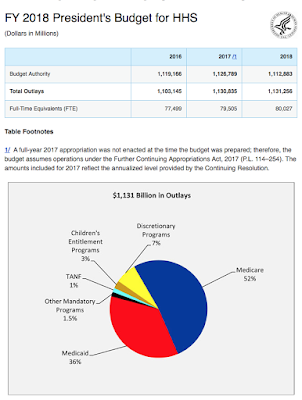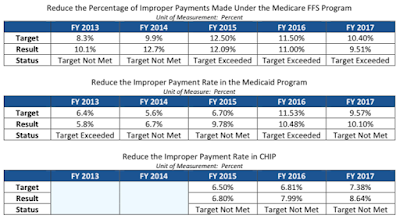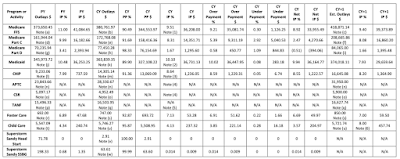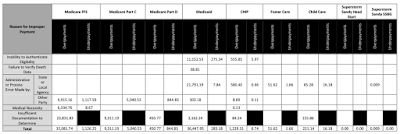
We all intuitively know that there is a significant amount of waste in government but one type of waste seems most egregious; improper government payments. This is a direct payer to payee waste of tax dollars and the recent 2017 Annual Report from the U.S. Department of Health and Human Services shows the massive size of waste in the health care system, a system that all of us will need at one time or another.
Let’s look at who the Department of Health and Human Services (HHS) is, in their own words:
“HHS is the U.S. government’s principal agency for protecting the health of all Americans, providing essential human services, and promoting economic and social well-being for individuals, families, and communities, including seniors and individuals with disabilities. HHS is responsible for more than a quarter of all federal outlays and administers more grant dollars than all other federal agencies combined. HHS’s Medicare program is the nation’s largest health insurer, handling more than one billion claims per year. Medicare and Medicaid together provide health care insurance for 1 in 3 Americans.”
Note that HHS is responsible for more than 25 percent of all federal government outlays and administers more grant dollars than all other federal agencies combined. Here is a graphic showing HHS budget for fiscal 2016 to 2018 and how those budget dollars are spent:
Being a bureaucracy, HHS and its massive budget are subject to payment errors, errors that cost all taxpayers. Let’s look at the HHS programs that are most susceptible to payment errors. In the 2017 version of the Payment Integrity Report, we find that the following HHS programs are susceptible to improper payments:
1. Medicare FFS – A federal health insurance program for people age 65 or older, people younger than age 65 with certain disabilities, and people of all ages with End-Stage Renal Disease (ESRD).
2. Medicare Part C – A federal health insurance program that allows beneficiaries to receive their Medicare benefits through a private health plan.
3. Medicare Part D – A federal prescription drug benefit program for Medicare beneficiaries.
4. Medicaid – A joint federal/state program, administered by the states, that provides health insurance to qualifying low-income individuals.
5. CHIP – A joint federal/state program, administered by the states, that provides health insurance for qualifying children.
6. Advanced Premium Tax Credit (APTC) – A federal insurance affordability program, administered by HHS and/or the states, to support enrollees in purchasing Qualified Health Plan (QHP) coverage from state and federal insurance exchanges.
7. Cost-sharing Reduction (CSR) – A federal insurance affordability program, administered by HHS and/or the states, operated on behalf of QHP enrollees to reduce the cost of deductibles, copayments, an coinsurance.
8. TANF – A joint federal/state program, administered by the states, that provides time-limited cash assistance as well as job preparation, work support, and other services to needy families with children to promote work, responsibility, and self-sufficiency.
9. Foster Care – A joint federal/state program, administered by the states, for children who need placement outside their homes in a foster family home or a child care facility.
10. CCDF – A joint federal/state program, administered by the states, that provides child care financial assistance to low-income working families.
11. Superstorm Sandy Head Start – A federal program that provides comprehensive developmental services for America’s low-income children from birth to 5 years of age and their families. Head Start received additional appropriations through the Disaster Relief Act to address the construction and other needs that arose from Superstorm Sandy.
12. Superstorm Sandy SSBG – A joint federal/state program, administered by the states, that supports programs designed to reduce dependency and promote self-sufficiency; to protect children, adults, and people with disabilities from neglect, abuse, and exploitation; and to help individuals who are unable to take care of themselves to stay in their homes or to find the best institutional arrangement. SSBG received additional appropriations through the Disaster Relief Act to address services for individuals and construction costs for facilities that arose from Superstorm Sandy.
Now, that we have that background, let’s look at a table showing the percentage of improper payments for the past five fiscal years for Medicare, Medicaid and Children’s Health Insurance Program (CHIP) p 18:
As you can see, the percentage of improper payments for Medicare has dropped over the past three fiscal years, however, the improper payment rate for Medicaid and CHIP are still significantly higher than they were five and three fiscal years ago respectively, despite government efforts to reign in its mistakes. In fact, the improper payment rate for Medicaid is nearly double what it was in fiscal 2013, rising from 5.8 percent to 10.1 percent. It is also interesting to note that for all three programs, the target rate for fiscal 2017 is significantly higher than it was in the past, particularly for Medicaid where it is up from 6.4 percent in fiscal 2013 to 9.57 percent in fiscal 2017. I guess if you set the error rate target high enough, it is easier to meet or exceed!
Now, to the meat of the matter. Here is a table showing the estimated and improper payments for the aforementioned twelve programs for fiscal 2016 to 2018 (in millions of dollars):
Here is a table showing the root causes for improper payments and the size of the over- or underpayments for each (in millions of dollars):
The overpayments for Medicare and Medicaid alone for fiscal 2018 hit $81.391 billion. This payment error is larger than the entire 2018 budget requests for the the Department of Education ($59.0 billion), the Department of Energy ($28.0 billion), Department of the Interior ($17.988 billion) and the Department of Homeland Security ($70.692 billion).
In case you were curious, the government has legislation in place, ordering federal agencies to identify and act on activities that may be susceptible to errors as shown in this quote from the Report of the Independent Auditors for HHS:
“The Improper Payments Information Act of 2002 (IPIA) (P.L. 107-300) as amended by the Improper Payments Elimination and Recovery Act of 2010 (IPERA) (P.L. 111-204) and the Improper Payments Elimination and Recovery Improvement Act of 2012 (P.L. 112-248) (hereinafter, the “Acts”) require federal agencies to identify the program and activities that may be susceptible to significant improper payments and estimate the amount of the improper payments.”
Here’s what the auditors have to say about Health and Human Services performance when it comes to improper payments:
“While the Department continues to make progress, HHS currently is not in full compliance with the requirements of the Acts. For example, HHS has reported improper payment error rates for each of its high-risk programs, or components of such programs, except for the Temporary Assistance for Needy Families (TANF).” (my bold)
From the data in this posting, I am hoping that you can see that Washington should be far more concerned about government waste in the health care system as opposed to how it deals with getting rid of Obamacare. With an aging population, my suspicion is that the level of improper payments to both Medicare and Medicaid will increase as the Department of Health and Human Services Department bureaucracy is flooded with even more claims than it is currently.
Click HERE to view more.
You can publish this article on your website as long as you provide a link back to this page.





Be the first to comment